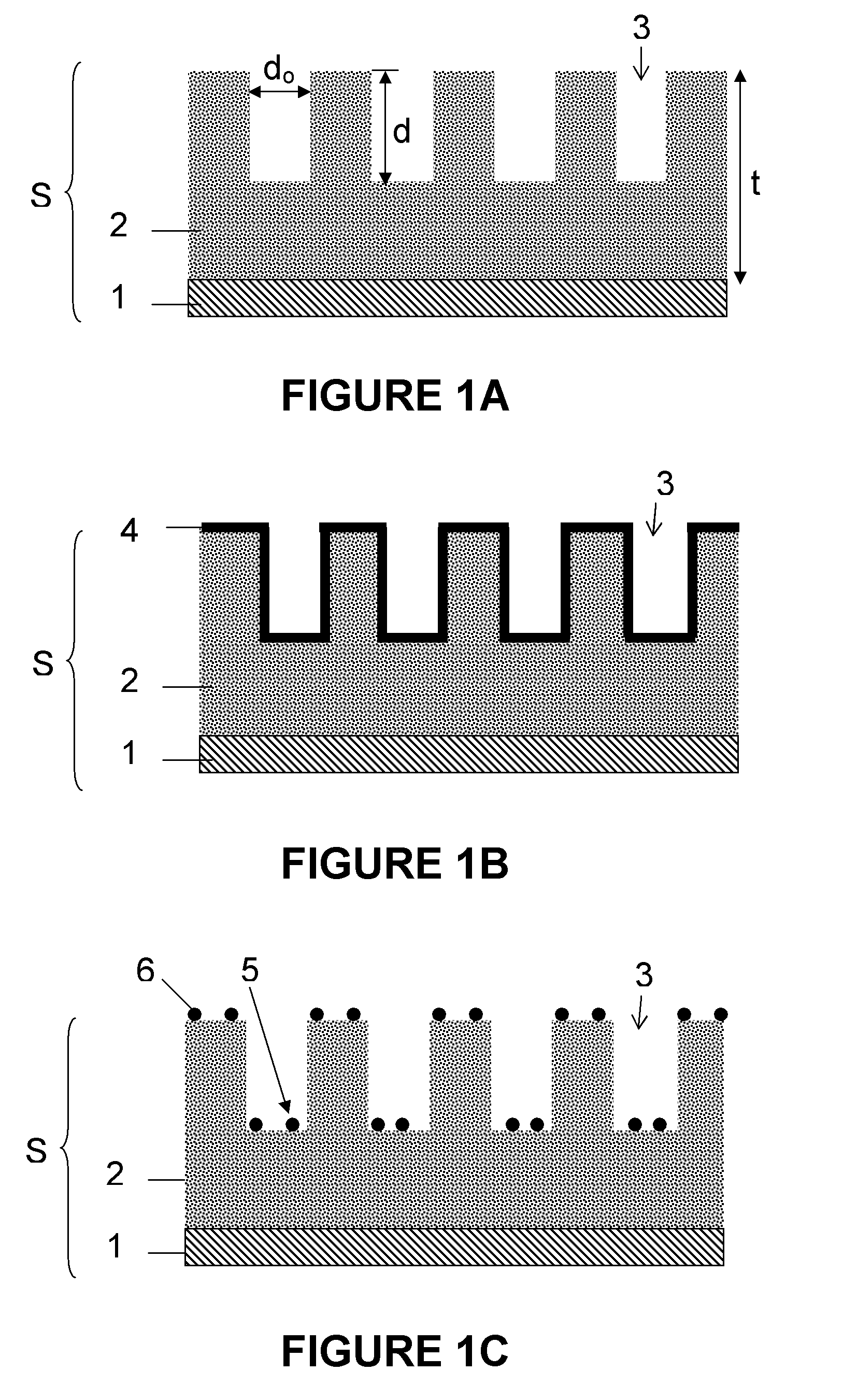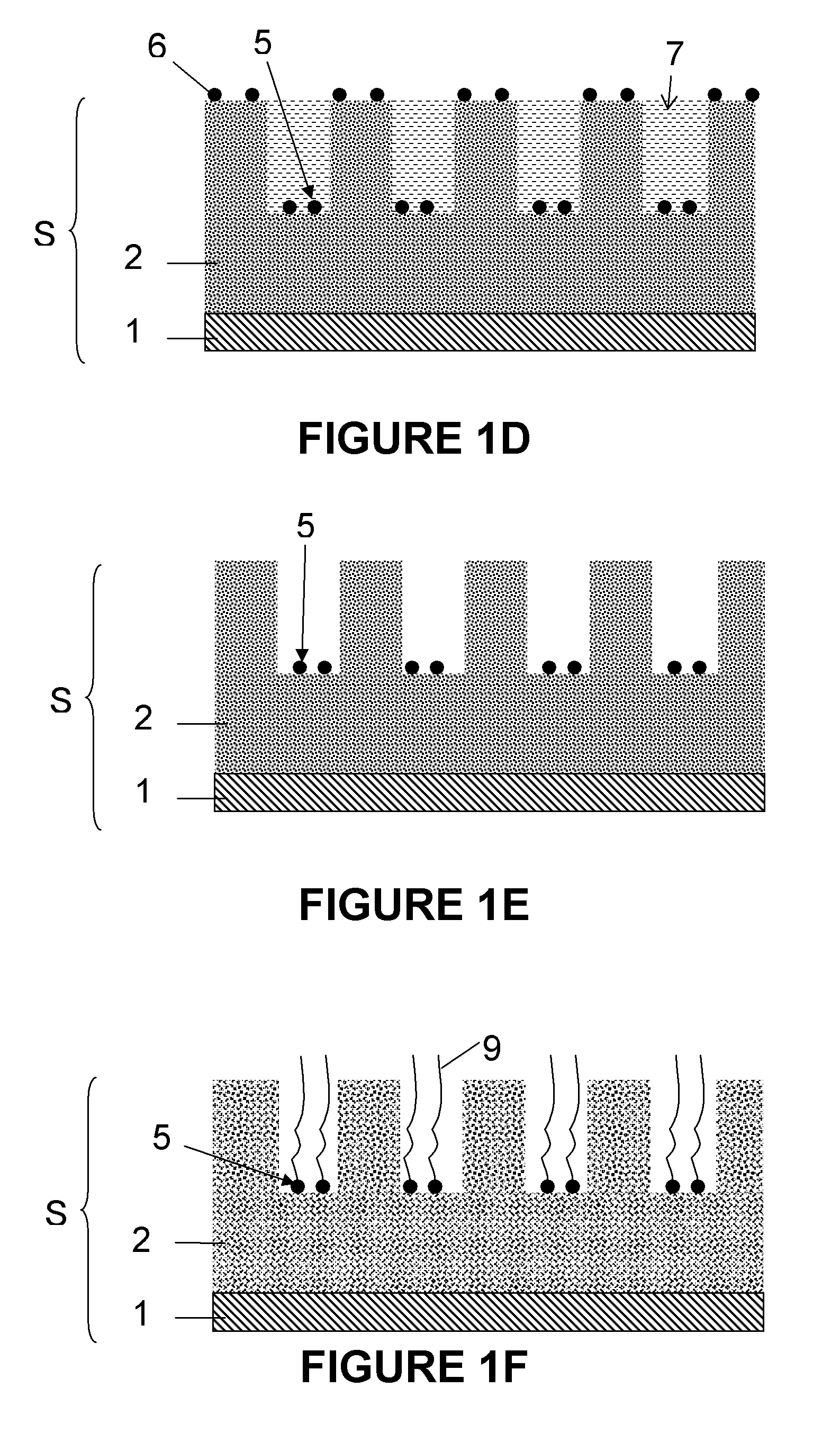Controlled and selective formation of catalyst nanaoparticles
a technology of catalyst nanoparticles and nanoparticles, which is applied in the field of catalyst nanoparticles, can solve the problems of incompatibility of current growth parameters, inability to synthesize different cnts with identical properties, and inability to fully realize similar applications
- Summary
- Abstract
- Description
- Claims
- Application Information
AI Technical Summary
Benefits of technology
Problems solved by technology
Method used
Image
Examples
example 1
Formation of Metal Nanoparticles
[0152]Pure metal nanoparticles 5, 6 resulting from an 8 nm and 2 nm thick layers of Ni and Co are evaluated.
[0153]A Ni layer 4 was deposited using Physical Vapor Deposition (PVD) and the layer 4 was annealed at a temperature of 700° C. for 1 minute. The nanoparticle size distribution was determined by SEM characterization. Under the mentioned annealing conditions, the particle diameter of the nanoparticles 5, 6 originating from the 8 nm thick deposited Ni layer was 67 nm±6 nm. The particle diameter of the nanoparticles 5, 6 originating from the 2 nm thick deposited Ni layer was 17 nm±4 nm.
[0154]Pure metal nanoparticles 5, 6 resulting from an 8 nm and 2 nm thick Co layer show exactly the same behavior as observed for Ni layers with the same thickness.
[0155]It can thus be concluded that the diameter of the nanoparticles 5, 6 depends on the thickness of the layer 4 of catalyst material, in the example given the thickness of the metal, i.e. Ni or Co, laye...
example 2
Growth of CNTs Using Co and Ni Nanoparticles as a Catalyst
[0156]In order to fully evaluate the catalytic activity of the Ni and Co (pure metal) nanoparticles 5 after the entire process of selectively obtaining nanoparticles 5 according to preferred embodiments, the Ni and Co nanoparticles 5 were exposed to a wide range of synthesis conditions. A CVD chamber was used for performing CNT growth. The system may comprise a load-lock pre-chamber from which samples can be transferred, using a magnetic transfer rod, to a fixed bed reactor comprising an 80 mm diameter quartz tube, 120 cm in length and surrounded by a horizontal furnace. The pressure of the system can be varied from atmospheric pressure to 1 mbar, whereas the temperature can reach 1200° C. A carbon source, hydrogen and nitrogen gases are supplied directly to the fixed bed reactor at flow rates ranging from 100 to 5000 ml / min and a maximum pressure of 3 bar. All samples were preconditioned at the desired growth temperature. Ea...
example 3
Evaluation of Growth Parameters in CVD Grown CNT
[0163]For a further evaluation of growth parameters as described in example 2, the time period of growth and the carbon source flow rate were reduced to respectively 30 seconds and 10 ml / min, while the growth temperature was increased to 900° C. An immediate effect on the growth of the CNTs 9 was observed. This is illustrated in FIG. 5C. Single CNTs 9 were grown from only some of the recesses 3, not from all of the recesses 3. Due to the limited amount of carbon source and reduced growth time, CNT length was controlled. In addition, an effect on the morphology was clearly observed. All CNTs 9 were straight. On the other hand, not all the nanoparticles appeared to be active under these circumstances. This is probably due to a poisoning effect at high temperature, as already described above.
PUM
| Property | Measurement | Unit |
|---|---|---|
| Temperature | aaaaa | aaaaa |
| Temperature | aaaaa | aaaaa |
| Evaporation enthalpy | aaaaa | aaaaa |
Abstract
Description
Claims
Application Information
 Login to View More
Login to View More - R&D
- Intellectual Property
- Life Sciences
- Materials
- Tech Scout
- Unparalleled Data Quality
- Higher Quality Content
- 60% Fewer Hallucinations
Browse by: Latest US Patents, China's latest patents, Technical Efficacy Thesaurus, Application Domain, Technology Topic, Popular Technical Reports.
© 2025 PatSnap. All rights reserved.Legal|Privacy policy|Modern Slavery Act Transparency Statement|Sitemap|About US| Contact US: help@patsnap.com



